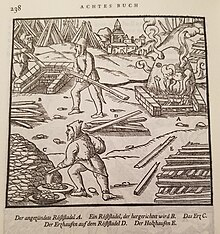Roasting (metallurgy)
In metallurgy, roasting or roasting refers to the treatment of ores containing sulfur , antimony and arsenic by heating them in roasting ovens . This creates roasting gases such as sulfur dioxide and arsenic trioxide ( hut smoke ). Other metal oxides formed during the roasting process with oxidation are subjected to a reducing treatment step.
Historically, iron ore had to be roasted to make it easier to crush and load a racing furnace . This was especially true for so-called. Magnetic ore, hematite and hematite . The ore was then crushed by hand with hammers or with a stamping mill .
Historically, sulfur-containing copper ore was z. B. copper pyrites or chalcopyrite are usually smelted in five work steps. In the first step, usually called cold roasting, the ore is made crumbly and some of the sulfur is removed. In the open air, the ore in the heap roasting is exposed to a wood fire for about 60 days. This creates a toxic smoke of sulfur dioxide and causes permanent environmental damage. Most of the time, forests were completely cut down for this. In the second step, the ore melted in a shaft furnace in about 15 days with the addition of charcoal to form raw stone, a mixture of iron, copper and sulfur. Iron was separated off by reaction with oxygen and sulfur. In the third step, another roasting process took place for around 40 days by repeatedly layering the ore in a brick, mostly roofed roasting barn. This step was called turning or alternating roasting. In the fourth step, roast melting, black copper was produced in the shaft furnace after about four days with the addition of charcoal. Finally, in the fifth step, the end product cooked copper was created in the cooking process after about a day through oxidizing melting. During the smelting, which lasted about 120 days, it was also possible to obtain elemental sulfur.
Roasting reaction process
The reducing roasting of metal sulfides to elemental metals (Me n S m → Me) takes place in two steps. First, two thirds of the metal sulfide is converted to the metal oxide with oxygen (O 2 ) . In the second step, heating is then continued in the absence of oxygen, as a result of which the remaining metal sulfide reacts with the resulting metal oxide to form the elemental metal and further sulfur dioxide .
Applications
Reduction of lead (II) sulfide to elemental lead :
- ( Roasting work )
- ( Reaction work )
Reduction of copper (I) sulfide to elemental copper :
Another example of metal sulfides, the metals of which are reduced during roasting , is mercury (II) sulfide .
Roast reduction process
The reduction takes place with carbon or carbon monoxide .
Applications
Pure lead can be obtained through the reducing roasting of lead gloss (PbS) and subsequent reduction of the metal oxide:
- The ore (galena) is reacted with oxygen ( roasting work ):
- The resulting lead (II) oxide is then reduced to lead by adding carbon ( reduction work ):
Also, antimony , copper and bismuth are prepared by roasting reduction process from the corresponding sulphide ores.
Oxidising roasting
Applications
By oxidation of pyrite arise iron (III) oxide and sulfur dioxide.
Iron (III) oxide is reduced to iron in blast furnaces and sulfur dioxide is used to obtain sulfuric acid.
swell
- AF Holleman , E. Wiberg , N. Wiberg : Textbook of Inorganic Chemistry . 101st edition. Walter de Gruyter, Berlin 1995, ISBN 3-11-012641-9 , p. 1321.
- Entry to roasting. In: Römpp Online . Georg Thieme Verlag, accessed on June 20, 2014.
- Christoph Andreas Schlüter: Thorough teaching of hut works , Braunschweig 1738 p. 151-160 ( digitized version of the Westphalian Wilhelms University ).
- Johan Gottschalk Wallerius : Beginnings of Metallurgy Leipzig 1770. P. 313–317
Web links
- Zeno.org , very detailed article "Roasting" from Meyers Konversationslexikon from 1905 - Different types of roasting, chemical processes during roasting, etc.
Individual evidence
- ↑ Ludwig Beck: The history of iron in technical and cultural-historical significance. 2nd volume. Friedrich Vieweg and Son , Braunschweig 1893–1895, pp. 89–94.






